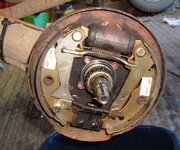FreeBirdTim
Silver Member
- Sep 24, 2013
- 3,844
- 6,911
- 🥇 Banner finds
- 1
- Detector(s) used
- Garrett AT Pro
- Primary Interest:
- All Treasure Hunting
Follow along with the video below to see how to install our site as a web app on your home screen.
Note: This feature may not be available in some browsers.
That's not a shear pin keyway setup afterall. The axle must have one spline to fit into the drum and not designed to shear, same as splined shaft but only one spline, nice match.

Your photo is of a simple spindle, not a drive axle. The keyway in your photo is for holding the thrust washer from spinning, which keeps the bearing from riding against the spindle nut.I don't know what you mean. Do you have a picture that supports that? Here is a picture of a VW rear spindle and it's definitely keyed.
View attachment 1150563
Granted this isn't a ford rear brake setup but I am sure they were similar. In any case, keyed rear brake spindles/drums were definitely used.
I'm not sure who you are responding too, but, I agree, most early model vehicles used a single keyway rear axle shaft and a corresponding hub to match. It's just that your photo was not of that setup. In most of these designs, the axle shaft was tapered so the hub was wedged tightly onto the axle shaft once the axle nut was torqued to it's proper setting. Also, in most cases, the hub and drum were an assembly, not one single piece. The drum was mounted to the hub and either riveted together or the studs were pressed into the hub and then staked to the drum. Chrysler had some of their early designs just the opposite. They pressed the stud through the drum and then staked it to the hub. Either way, if the drum was ruined or beyond specs, it could be replaced without having to replace the hub also. That saved some cost. The earlier VW type I, II, and III were an exception. Their rear hub and drum were one piece and were replaced as such. Everyone of those I worked on from 1955 and newer used a multi-splined hub......no keyway. It also wasn't a tapered setup. I worked on some of the '54 and earlier VW's too, but, so few of them that I don't remember having the rear brakes apart on those to give you any info on how they were designed. I'm sure you can look it up if you're itching to find out.Regardless of what you think my picture shows, and I believe you are wrong, many early rear brake drums were keyed.

I think I would use it as and Umbrella holder. Would go nice with a table and chairs.
Found a couple of old auto parts in the woods today. Here's the first one. Is it a brake drum? Water pump? Guesses?
View attachment 1142036View attachment 1142037
I'm not sure who you are responding too, but, I agree, most early model vehicles used a single
keyway rear axle shaft and a corresponding hub to match. It's just that your photo was not of that setup. In most of these designs, the axle shaft was tapered so the hub was wedged tightly onto the axle shaft once the axle nut was torqued to it's proper setting. Also, in most cases, the hub and drum were an assembly, not one single piece. The drum was mounted to the hub and either riveted together or the studs were pressed into the hub and then staked to the drum. Chrysler had some of their early designs just the opposite. They pressed the stud through the drum and then staked it to the hub. Either way, if the drum was ruined or beyond specs, it could be replaced without having to replace the hub also. That saved some cost. The earlier VW type I, II, and III were an exception. Their rear hub and drum were one piece and were replaced as such. Everyone of those I worked on from 1955 and newer used a multi-splined hub......no keyway. It also wasn't a tapered setup. I worked on some of the '54 and earlier VW's too, but, so few of them that I don't remember having the rear brakes apart on those to give you any info on how they were designed. I'm sure you can look it up if you're itching to find out.
IMO cudamark solved it with tihs post, crazyhorse is in the mix too.